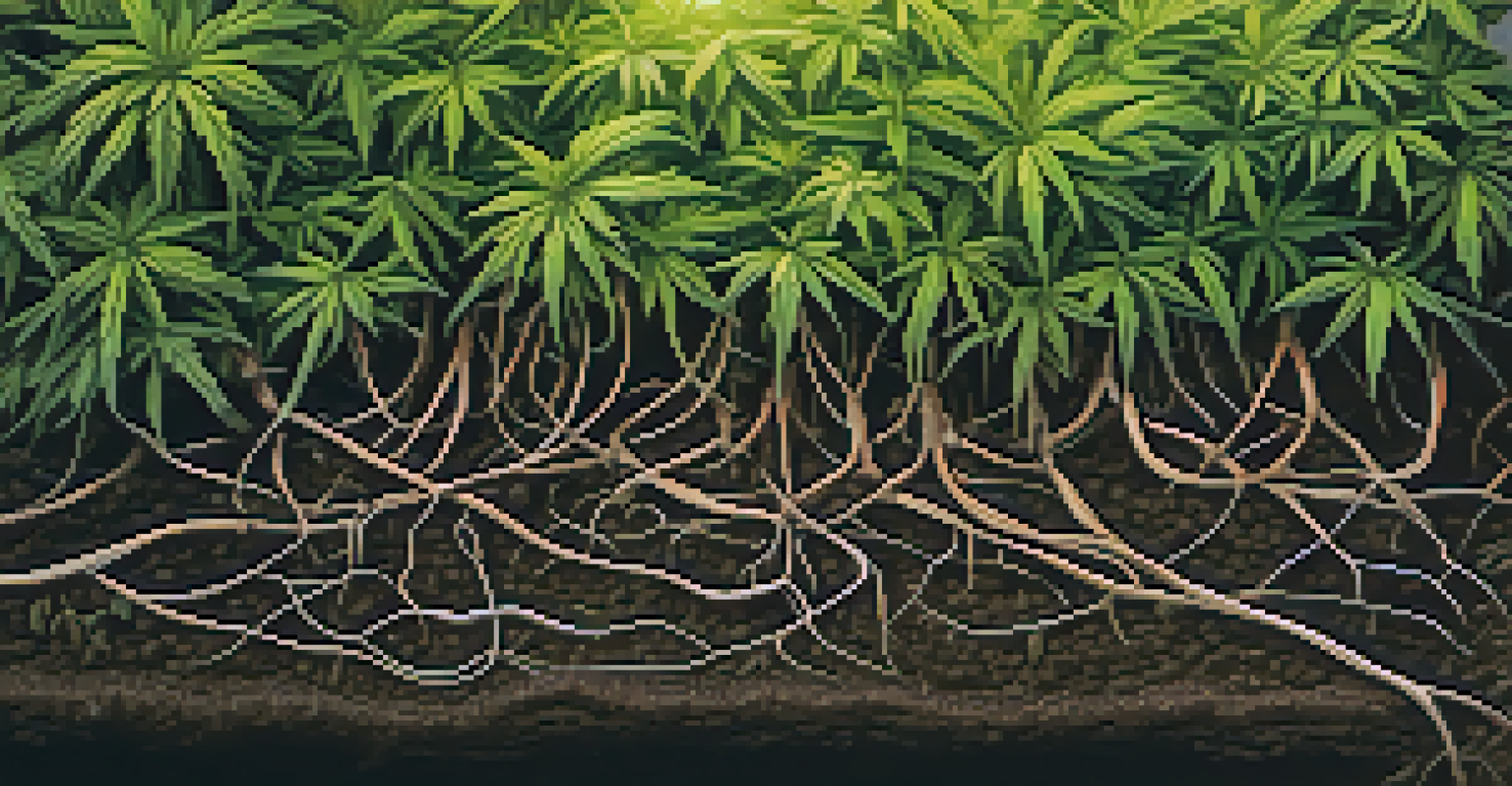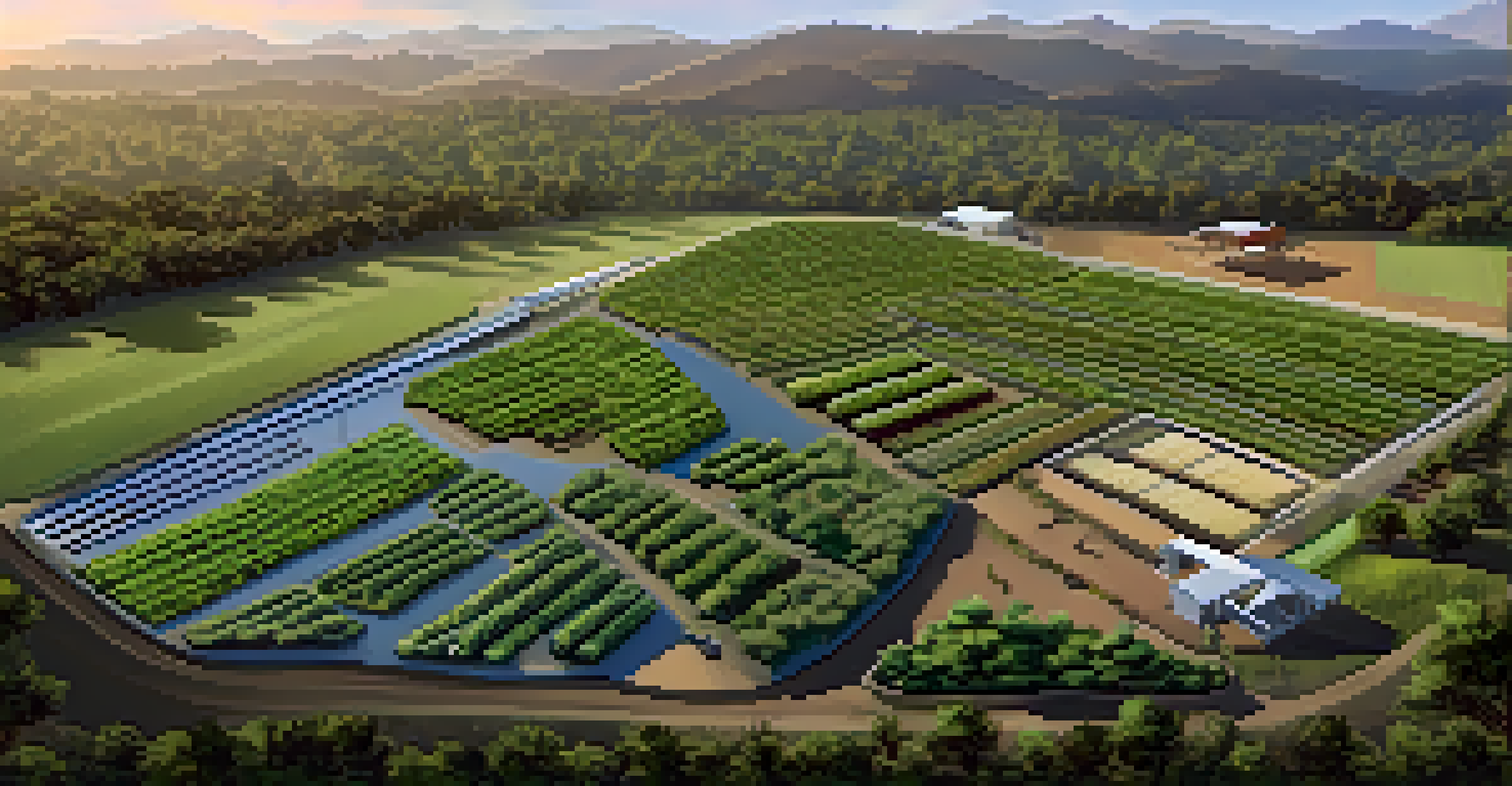Marijuana Cultivation and Its Effects on Soil Health

Understanding Marijuana Cultivation Practices
Marijuana cultivation involves various farming techniques that can significantly affect soil health. Growers may use methods such as indoor hydroponics or outdoor farming, each having different impacts on the land. For instance, indoor systems often rely on artificial nutrients, while outdoor farms might enhance biodiversity through crop rotation.
The health of the soil is the foundation of all agriculture.
The choice of cultivation method can influence soil structure, nutrient availability, and microbial activity. Organic farming practices, which emphasize natural fertilizers and pest control, can lead to healthier soils. However, conventional methods that rely on chemical inputs may degrade soil health over time, leading to long-term ecological consequences.
Understanding these practices is crucial for assessing their environmental impact. As marijuana becomes more mainstream, the importance of sustainable cultivation techniques will only grow. Educating growers about best practices can foster a healthier relationship between cannabis farming and soil health.
Soil Nutrients: The Role of Marijuana Cultivation
Soil nutrients are vital for healthy plant growth, and marijuana is no exception. The cultivation of marijuana can either enhance or deplete soil nutrients, depending on the methods used. For instance, nutrient-rich soils are essential for high-quality yields, but excessive harvesting without replenishing can lead to nutrient depletion.

Growers often implement fertilization strategies to maintain soil fertility, yet not all fertilizers are created equal. Organic fertilizers, such as compost or manure, can improve soil structure and microbial health, while synthetic fertilizers might provide quick fixes but can lead to nutrient runoff and soil acidification. This balance is crucial for sustaining soil health over time.
Sustainable Practices Enhance Soil Health
Implementing sustainable cultivation techniques, such as organic farming and cover crops, can significantly improve soil health in marijuana cultivation.
Ultimately, the approach to managing soil nutrients during marijuana cultivation can have long-lasting effects. By focusing on sustainable practices, growers can ensure that their soil remains fertile for future crops. This consideration can help create a more sustainable agricultural landscape.
Impact of Marijuana on Soil Microbial Communities
Soil health is not just about nutrients; it's also about the microbial communities that thrive within it. Marijuana cultivation can impact these communities, which play a crucial role in nutrient cycling and organic matter decomposition. A diverse microbial community often indicates a healthy soil ecosystem, while monocultures may lead to imbalances.
Sustainable agriculture is a way of farming that improves the health of the environment, economy, and community.
When marijuana is grown in a way that promotes biodiversity, it can enhance microbial diversity. Practices like intercropping or adding cover crops can introduce beneficial microbes that improve soil health. Conversely, heavy pesticide and herbicide use can disrupt these microbial populations, leading to negative consequences for soil vitality.
Understanding the relationship between marijuana cultivation and soil microbes is essential for sustainable farming. By fostering healthy microbial communities, growers can improve soil resilience and productivity. This relationship highlights the interconnectedness of plant and soil health in cannabis cultivation.
Erosion and Soil Structure: Challenges in Cultivation
Soil erosion is a significant concern in any agricultural practice, including marijuana cultivation. Erosion occurs when soil is worn away by water, wind, or human activity, leading to loss of fertile topsoil. Marijuana plants, especially when grown in large monoculture fields, can leave soil vulnerable to erosion if not properly managed.
To combat erosion, growers can implement various soil conservation techniques, such as contour farming or planting cover crops. These practices help maintain soil structure and reduce runoff. Additionally, maintaining organic matter in the soil can improve its ability to retain moisture, further mitigating erosion risks.
Water Management is Key to Success
Effective water management strategies, like drip irrigation and rainwater harvesting, are crucial for maintaining soil moisture and preventing erosion in marijuana farming.
Addressing soil erosion in marijuana cultivation is essential for long-term sustainability. By prioritizing soil structure and implementing erosion control measures, growers can protect their fields and ensure healthy soils for future crops. This approach not only benefits the grower but also supports the broader ecosystem.
Water Management in Marijuana Cultivation
Water management is crucial in marijuana cultivation as it directly affects soil health. Proper irrigation practices can improve soil moisture levels, promoting healthy plant growth. However, excessive watering can lead to soil saturation and erosion, while insufficient watering can stress plants and deplete soil nutrients.
Growers can adopt methods such as drip irrigation to deliver water more efficiently, reducing waste and runoff. This technique allows for precise watering, ensuring that plants receive the moisture they need without overwhelming the soil. Additionally, rainwater harvesting can be a sustainable way to manage water resources.
Effective water management not only supports healthy marijuana plants but also benefits soil health. By conserving water and minimizing erosion, growers can enhance the resilience of their soils. This holistic approach to water management is vital for sustainable marijuana cultivation.
The Use of Cover Crops in Marijuana Farming
Cover crops are an essential tool in sustainable agriculture, including marijuana farming. These crops, grown primarily to cover the soil, can enhance soil health by preventing erosion, improving nutrient content, and promoting biodiversity. Incorporating cover crops into marijuana cultivation can create a more resilient farming system.
For example, planting legumes as cover crops can naturally fix nitrogen in the soil, reducing the need for synthetic fertilizers. This not only benefits the marijuana plants but also contributes to the overall health of the soil ecosystem. Additionally, cover crops can suppress weeds and improve soil structure, creating a healthier environment for growth.
Microbial Diversity Supports Growth
Promoting microbial diversity through practices like intercropping can enhance soil resilience and nutrient cycling, benefiting marijuana plants and the overall ecosystem.
The integration of cover crops in marijuana farming represents a shift towards more sustainable practices. By prioritizing soil health through cover cropping, growers can create a more balanced ecosystem. This approach not only supports their crops but also contributes positively to the environment.
Conclusion: The Future of Marijuana Cultivation and Soil Health
As marijuana cultivation becomes more widespread, the importance of sustainable practices becomes increasingly clear. The health of the soil is directly tied to the quality of the crops produced and the overall health of the ecosystem. By implementing responsible farming techniques, growers can significantly impact soil health and, in turn, their yields.
Looking ahead, education and awareness around sustainable practices will be crucial. Growers who prioritize soil health will not only benefit their crops but also contribute to a more sustainable future for agriculture as a whole. Collaboration among farmers, researchers, and policymakers can pave the way for innovative solutions in marijuana cultivation.

Ultimately, the future of marijuana cultivation relies on the health of the soil. By fostering a deeper understanding of these practices, we can ensure that both the industry and the environment thrive. Sustainable marijuana cultivation is not just a trend; it's a necessary step towards a healthier planet.